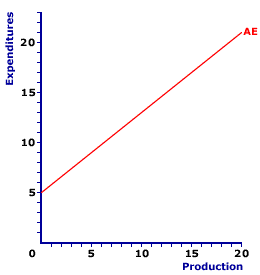
|
|
GRESHAM'S LAW: A principle stating that bad money drives good money out of circulation. For this law to apply an economy clearly needs two types of money, one considered good and the other considered bad. Good and bad money in this context has nothing to do with the propensity to torture small animals or attempts at world domination. Good and bad are based on the official value in exchange versus value in use. Gold and silver, which were both used as money in the U.S. Economy in the 1800s, provides an illustration. Silver took on the role of "bad money" because it was relatively less value in use than gold. As such, people used silver as everyday money and stockpiled, or hoarded, gold. The silver bad money drove the gold good money out of circulation.
Visit the GLOSS*arama
|
|


|

|
                           INTERCEPT, AGGREGATE EXPENDITURES LINE: The intercept of the aggregate expenditures line indicates autonomous expenditures, aggregate expenditures that do not depend on the level of income or production. This can be thought of as aggregate expenditures that the four macroeconomic sectors (household, business, government, and foreign) undertake regardless of the state of the economy. Autonomous expenditures are affected by the aggregate expenditures determinants, which cause a change in the intercept and a shift of the aggregate expenditures line. | Aggregate Expenditures Line | 
|
The aggregate expenditures line, which embodies the key Keynesian principle of effective demand, shows the relation between aggregate expenditures and the actual level of aggregate income or production in the domestic economy. The income and production measures commonly used are national income and gross domestic product.The two basic types of expenditures--autonomous and induced--are indicated by the aggregate expenditures line. - Autonomous expenditures are the vertical intercept, or Y-intercept, of the aggregate expenditures line. This is the sum of autonomous consumption, autonomous investment, autonomous government purchases, and autonomous net exports, with an adjustment for autonomous taxes.
- Induced expenditures are the slope of the aggregate expenditures line. The marginal propensity to consume (MPC), which is the slope of the consumption line, forms the foundation of the slope of the aggregate expenditures line. This slope, however, is augmented by the marginal propensity to invest (MPI), marginal propensity for government purchases (MPG), and marginal propensity to import (MPM).
A representative aggregate expenditures line is presented in the exhibit to the right. This red line, labeled AE in the exhibit, is positively sloped, indicating that greater levels of income generate greater aggregate expenditures by the four sector. This positive relation is primarily based on the Keynesian psychological law indicating that consumption expenditures are induced by household income. However, this positive slope is reinforced and augmented by induce investment, government purchases, and net exports.The intercept of the aggregate expenditures line indicates the intersection point between the aggregate expenditures line and the vertical expenditures axis. The aggregate expenditures line intersects the vertical axis in this exhibit at a value of $5 trillion. Theoretically, this is a minimum "baseline" level of aggregate expenditures, the amount of investment undertaken if income and production fall to zero. This intersection indicates autonomous expenditures--aggregate expenditures unrelated to income. Click the [Intercept] button to illustrate. Autonomous expenditures are aggregate expenditures by the household, business, government, and foreign sectors that are unrelated to and unaffected by the level of income or production. This is best indicated by a zero level of income. While individuals, business firms, government agencies, or foreign entities might occasionally come face-to-face with autonomous expenditures, as their own slice of aggregate income drops to zero, for the aggregate economy autonomous expenditures is mostly an unlikely theoretical extrapolation. However, from an analytical perspective, the intercept of the aggregate expenditures line is affected by the aggregate expenditures determinants. These are ceteris paribus factors other than income and production that affect aggregate expenditures, but which are held constant when the aggregate expenditures line is constructed. A few of the more important determinants are interest rates, expectations, fiscal policy, and wealth. Any change in these determinants cause the aggregate expenditures line to shift, which necessarily means a new intercept and a new level of autonomous expenditures.

Recommended Citation:INTERCEPT, AGGREGATE EXPENDITURES LINE, AmosWEB Encyclonomic WEB*pedia, http://www.AmosWEB.com, AmosWEB LLC, 2000-2024. [Accessed: May 2, 2024].
Check Out These Related Terms... | | | | | | | | | |
Or For A Little Background... | | | | | | | | | | | | | | | |
And For Further Study... | | | | | | | | | | |
Search Again?
Back to the WEB*pedia
|



|

|
GREEN LOGIGUIN
[What's This?]
Today, you are likely to spend a great deal of time watching the shopping channel trying to buy either a T-shirt commemorating last Friday (you know why) or a rotisserie oven that can also toast bread. Be on the lookout for florescent light bulbs that hum folk songs from the sixties.
Your Complete Scope
This isn't me! What am I?
|

|
|
Paper money used by the Commonwealth of Massachusetts prior to the U.S. Revolutionary War, which was issued against the dictates of Britain, was designed by patriot and silversmith, Paul Revere.
|

|
|
"Leadership is based on inspiration, not domination; on cooperation, not intimidation. " -- William A. Ward
|

|
AMEX
American Stock Exchange
|

|
|
Tell us what you think about AmosWEB. Like what you see? Have suggestions for improvements? Let us know. Click the User Feedback link.
User Feedback
|


|


